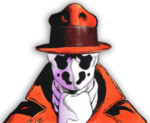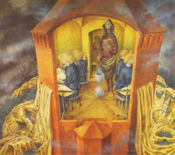Difference between revisions of "Chapter 1"
| Line 41: | Line 41: | ||
a: 11, b: 2 - '''Wendell ("Mucho") Maas'''<br> | a: 11, b: 2 - '''Wendell ("Mucho") Maas'''<br> | ||
| − | "Mucho más" is common Spanish phrase, meaning "much more." | + | "Mucho más" is common Spanish phrase, meaning "much more." Mucho Maas reappears in ''Vineland''. |
a: 11, b: 2 - '''Pachuco dialect'''<br> | a: 11, b: 2 - '''Pachuco dialect'''<br> | ||
Revision as of 16:07, 29 June 2007
- Please keep these annotations SPOILER-FREE by not revealing information from later pages in the novel.
| If your edition has 183 pages, follow the pages marked a: | If your edition has 152 pages, follow b: |
</br>
a: 9, b: 1 - Oedipa
Oedipus was the mythical king of Thebes who unknowingly killed his father and married his mother. Wikipedia Oedipus the King, aka Oedipus Rex, is a Greek tragedy written by Sophocles and first performed in 428 BC. Many critics, including Aristotle, consider it the greatest tragedy ever written. Wikipedia
- Whether Oedipa has anything to do with Oedipus is an open question. Some critics find zero connection and note that the name indicates that names are only words, and not necessarily full of meaning (mysteries without answers being a theme in CoL49). Others have teased various interpretations from Sophocles' play to connect its protagonist to Pynchon's. So far, no single explanation is remotely concrete or thoroughly convincing.
- Oedipa's name is probably pronounced in the American fashion, ED-i-pa, not British fashion, EED-i-pa, because Mucho uses the short form "Oed," which almost has to be ED.
- A further comic level in the name Oedipa: It looks like a feminization of Oedipus, which is a Latin name derived from the Greek Oidipous. While -pus has the look of a word-ending that might alternate between masculine and feminine forms, like proper names Julius/Julia or adjectives sanctus/sanctum/sancta, in fact it stands in for Greek -pous, meaning "foot," a form that doesn't alternate. (All feet are the same gender no matter who's wearing them.) Whoever coined the name Oedipa pretended to know a little more than they really did.
Additionally, there is the Freudian concept of the Oedipal Complex. Basically, a son loves his mother (in an unconscious sexual way) and is jealous of his father and wants to kill him and have his mom all to himself. The daughter version of this is called the Electra Complex. In the Electra Complex the daughter is upset that she has no penis and is jealous of her father's penis and becomes angry at him ("penis envy").
a: 10, b: 1 - Mazatlán
a Mexican city on Mexico's Pacific coast. Pynchon lived in Mexico during parts of the 1960s.
a: 10, b: 1 - Cornell University
Pynchon's alma mater.
a: 10, b: 1 - a dry, disconsolate tune
In the fourth movement of Béla Bartók's Concerto for Orchestra the "Serenade" theme is a paraphrase of the patriotic operetta hit by a certain Zsigmond Vincze, "You are fair, you are beautiful, o Hungary" (supposed to be an expression of exiled Bartók's nostalgia, tinged with a complex irony). This is broken off in a mock-Shostakovichian manner ("enter the Drunken Gang") by another modified operetta hit from Franz Lehár's The Merry Widow.
a: 10, b: 1 - Jay Gould
(1836 – 1892) was an American financier, who became a leading American railroad builder and speculator. In his lifetime and for a century after, Gould had a firm reputation as the most unethical of the 19th century American businessmen known as robber barons. Wikipedia
a: 10, b: 2 - Warpe, Wistfull, Kubitschek and McMingus
As Pynchon is a lifelong Jazz fan, the final name could be a nod to jazz legend Charles Mingus.
a: 10, b: 2 - Kinneret-Among-The-Pines
Fictional California town. Kinneret is the modern Hebrew name for the Sea of Galilee in Israel, upon the shores of which much of ministry of Jesus occurred.
a: 10, b: 2 - settecento
Settecento is the Italian word for seven hundred, and is the standard Italian term for the 18th century (not the 17th century, but the years beginning with 17). In English, it refers to styles of that period.
a: 10, b: 2 - Vivaldi Kazoo Concerto
Kazoos appear in Gravity's Rainbow. The title isn't as outlandish as it may seem; Vivaldi's concerti are often performed on instruments they were not written for. Example: concerto for two cellos recast for bassoon trio.
a: 10, b: 2 - Boyd Beaver
The name sounds suspiciously similar to Zoyd Wheeler, the protagonist of Vineland.
a: 11, b: 2 - Wendell ("Mucho") Maas
"Mucho más" is common Spanish phrase, meaning "much more." Mucho Maas reappears in Vineland.
a: 11, b: 2 - Pachuco dialect
Pachucos were Mexican American youth who developed their own subculture during the 1930s and 1940s in the Southwestern United States. They wore distinctive clothes (such as Zoot Suits) and spoke their own dialect (Caló). Wikipedia Zoot suits appear a few times in Gravity's Rainbow.
a: 11, b: 2 - chingas and maricones
Spanish slang for "fuck" and "faggot".
a: 11, b: 3 - Lamont Cranston
One identity adopted by The Shadow, a character of pulp fiction, radio shows, and comic books. Cranston was a wealthy young man about town. Wikipedia
a: 11, b: 3 - Commissioner Weston... Professor Quackenbush
?
b: 4 - Mucho shaved his ... throw them further off
All of the references in this section refer to the stereotypical (often Italian) used car salesman with greased back hair, a very short mustache, and huge lapels on his suit.
American actor (1925-2001). He became a favorite actor of director Billy Wilder, starring in his films Some Like It Hot, The Apartment and others. Wilder felt Lemmon had a natural tendency toward overacting that had to be tempered; the Wilder biography Nobody's Perfect quotes the director as saying: "Lemmon, I would describe him as a ham, a fine ham, and with ham you have to trim a little fat." Wikipedia
a: ?, b: 4 - creampuff
A very well maintained used car.
a: 16, b: ? - Dr. Hilarius, her shrink or psychotherapist
Shrink is a shortened form of headshrinker, which is 50s slang. The OED cites 'shrink' in this text of 1966, as the first recorded written use of it as a slang term. Which must be why Pynchon defined it in the text.
a: 17, b: 8 - LSD-25, mescaline, psilocybin
These hallucinogenic drugs are also mentioned in Gravity's Rainbow. It remains an open question as to whether and to what extent Pynchon took or was influenced by them. ("whether"?)
a: ?, b:8 - lapses from orthodoxy
Orthodox Freudian psychotherapy involved the therapist literally trying not to impose himself at all on the patient. That's why the therapist is often shown sitting behind the patient. The goal is to be a blank canvas and have the patient paint his problems on the therapist, thereby bringing them into consciousness.
a: 18, b: 8 - Rorschach blot
The Rorschach inkblot test (Pronounced roar-shock) is a method of psychological evaluation. Psychologists use this test to try to examine the personality characteristics and emotional functioning of their patients. Wikipedia
a: 18, b: 8 - a face is symmetrical like a Rorschach blot
In the graphic novel, Watchmen, written by Alan Moore, there is a character named Rorschach who wears a mask with a Rorscach blot on the front. Moore is a self-professed Pynchon fan: he referenced V. in V for Vendetta and has mentioned Gravity's Rainbow in interview. It is possible, not to say probable, that Moore was inspired by this line.
a: 18, b: 8 - TAT picture
The TAT is popularly known as the picture interpretation technique because it uses a standard series of 31 provocative yet ambiguous pictures about which the subject must tell a story. It was developed by American psychologists in the 1930s. Wikipedia
a: 18, b: 9 - Fu-Manchu
Dr. Fu Manchu is a fictional character, an evil genius of Chinese origin, first featured in a series of novels by Birmingham author Sax Rohmer during the first half of the 20th century. Wikipedia
a: 18, b: 9 - Perry Mason
Perry Mason is a fictional defense attorney who originally appeared in detective fiction by Erle Stanley Gardner. Mason was portrayed by Raymond Burr in a television series which ran on CBS from 1957 to 1966. The typical plot involves Perry Mason unmasking the actual murderer in a final dramatic courtroom showdown. Wikipedia
a: 19, b: 9 - The Profession v. Perry Mason...
Roseman may be trying to undermine Perry Mason by arguing that the dramatic courtroom twists in the TV show are actually uncommon in the American legal system.
a: 21, b: 11 - Bornando el Manto Terrestre
Remedios Varo (1908 - 1963) was a surrealist painter. Wikipedia
Bill Brown notes that "Pynchon saw Bordando el Manto Terrestre when, as part of the first full retrospective of the painter's work, it was displayed at the Palacio de Bellas Artes in Mexico City in 1964, a year after her death at the age of 55. Painted in 1961, el Manto (oil on masonite, roughly 40 by 48 inches) is the central panel in an autobiographical triptych. It is possible that Pynchon, writing Lot 49 in 1965, recalled the painting from memory or incomplete notes, and not with a reproduction of it set in front of him. He gets a lot wrong."
a:21, b:11 - she wore dark green bubble shades
This is the sixties, after all...
| Chapter 1 | Chapter 2 | Chapter 3 | Chapter 4 | Chapter 5 | Chapter 6 |
|---|




